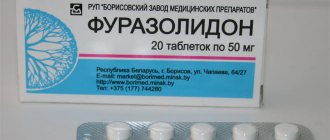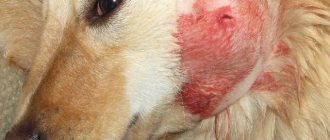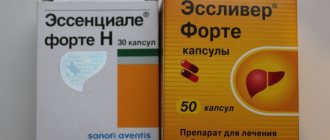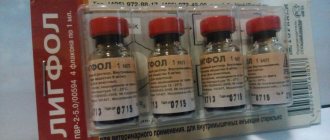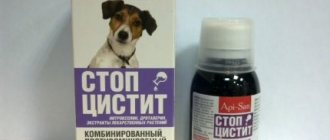Composition and therapeutic effect
Albucid is a sulfonamide derivative. The substance has a wide spectrum of antimicrobial action, active against pathogenic streptococci, staphylococci, chlamydia, Escherichia and other gram-positive and gram-negative bacteria.
Another name for Albucid is sodium sulfacyl. The drug is successfully used in medicine for the treatment of ophthalmological diseases in humans, including purulent corneal ulcers, conjunctivitis, blepharitis, gonorrheal eye diseases in children and adults. The medicine can be used even in newborns; its popularity is explained by its high effectiveness and low price.
However, the drug is not recommended for use in animals. Veterinarians answer the question of pet owners in this case categorically: “No!” The reasons are the aggressive action of sodium sulfacyl on the cornea of the dog’s eye. In mild manifestations, it can cause a strong burning sensation, provoke the development of chronic conjunctivitis, and in severe cases, you can even burn the cornea of the eye.
Eye diseases in dogs
Eye diseases are common in pets. Colds, viral diseases, foreign bodies entering the eye - all this requires qualified assistance from a specialist. Treatment requires special medications, which only a veterinarian can choose correctly. Veterinary drugs are preferred, although "human" drugs may sometimes be used.
Representatives of some breeds have characteristic features of the structure of the organ of vision, as a result of which the eyes are more susceptible to diseases than others. Spaniels, Shar-Peis, Mastiffs, and Basset Hounds are characterized by sagging eyelids, which results in excessive tearing. Pekingese and pugs have slightly bulging eyes, which also causes discharge from the eyes. Dogs of long-haired breeds - lap-dogs, collies, poodles, Yorkies, Afghans - Afghan hounds - also suffer more often than others from eye diseases. The reason for frequent visits to the veterinarian due to eye diseases is brachycephalic syndrome, characteristic of bulldogs, boxers, and Pomeranians.
As dogs age, they can develop a cloudy cornea, which is caused by a lack of tear fluid. It may be accompanied by purulent discharge from the eyes and chronic conjunctivitis.
The initial symptoms of ophthalmic diseases in pets are redness of the eyelid mucosa, swelling, clear, mucous or purulent discharge from the eyes, and frequent blinking. Among the most common diseases are conjunctivitis, blepharitis, and keratitis.
Conjunctivitis in dogs
This is an inflammation of the mucous membrane of the eye - the conjunctiva. Most often, the disease develops as a secondary one and is non-infectious in nature. There are several types of disease:
- allergic – as a consequence of atopy or manifestations of food allergies. In some situations, it is the only symptom of an allergy, manifested by increased lacrimation, mucous or purulent discharge, itching, blepharitis (inflammation of the eyelid);
- Follicular conjunctivitis is an immune-related disease characteristic of young dogs. With it, the conjunctiva turns red, multiple follicles form on the inner and outer surfaces of the third eyelid;
- bacterial – develops as a secondary disease when the balance of microflora in the body is disturbed. The causes of development may be eye injury, foreign bodies, dry eye syndrome, systemic infectious diseases (for example, distemper), hypersensitivity to eye drops and other medications for topical use.
Blepharitis
This is a chronic inflammatory disease that most often affects both eyes. The cause in most cases is an allergy; characteristic symptoms include redness and thickening of the edges of the eyelids, itching, mucous or purulent discharge, and blepharospasm. There are two types of blepharitis. Focal (barley) can be external, when the abscess is located on the edge of the eyelid on the outside, and internal (another name is meibomitis), when the sebaceous glands become inflamed on the inside.
Diffuse blepharitis does not develop independently; it is always a concomitant disease, in particular with allergies and various chronic pathologies, and can accompany demodicosis or fungal diseases - microsporia, trichophytosis. The following types of disease are distinguished:
- scaly - accompanied by redness and swelling of the eyelids, the appearance of grayish-white scales on the eyelids and eyelashes;
- ulcerative - redness and thickening of the eyelid, the formation of purulent crusts, under which bleeding ulcers appear;
- marginal - inflammation of the edges of the eyelids, accompanying infectious diseases, chronic conjunctivitis;
- allergic – as a manifestation of an allergic reaction of the body, it can occur in an acute form;
- demodicosis – accompanied by itching, baldness in the area of the eyelids and eyelashes.
Keratitis
This is the name for an inflammatory disease that affects the transparent membrane of the eye, the cornea. The pathology is common in pets, and certain dog breeds have a genetic predisposition to it.
In shepherd dogs, as well as in Labradors and Staffordshire terriers, sometimes in huskies, collies, St. Bernards and some other breeds, pannus is diagnosed - the so-called shepherd keratitis. The autoimmune disease is characterized by the appearance of brown pigmentation of the conjunctiva, clouding of the cornea, and the appearance of blood vessels on it - the so-called red shaft. Treatment is lifelong, with courses of antibiotics.
In boxers, Pekingese, pugs and French bulldogs, keratitis most often affects one eye and manifests itself as chronic non-healing erosion of the cornea. The defect, invisible at first, eventually manifests itself with characteristic symptoms - erosion, blepharospasm (squinting of the eye), tearful or purulent discharge. Later, blood vessels appear on the cornea, which is why the eye always appears inflamed.
In dachshunds, the pathology is autoimmune in nature; at an early stage, local irritation of the eyelid and pinpoint clouding of the cornea appear, then it loses transparency; in advanced cases, without treatment, the animal may develop blindness.
Eye drops and ointments
Dog eye treatment is often done with drops and ointments. They are especially effective for conjunctivitis, blepharitis, and keratitis. Both veterinary and human drugs are used. Diamond eyes drops are effective for treating conjunctivitis in dogs; they are sold at any veterinary pharmacy.
Technique for introducing drops into a dog's eye
But what to do if there is no way to quickly get to a veterinary pharmacy - human resources will also help you. If your dog's eyes are watery, boric acid can be instilled, and purulent discharge should be treated with tetracycline ointment.
Video on eye rinsing in dogs
Veterinary ointments, lotions and drops for eye treatment
Diamond Eyes - eye drops for dogs and cats. The drug contains as active ingredients: chlorhexidine digluconate - 0.00015 g/ml, taurine - 0.02 g/ml, succinic acid - 0.001 g/ml. Dogs weighing up to 10 kg - 1 drop, dogs weighing more than 10 kg - 2 drops. When treating the eyes 3 times a day, the drug is used for no more than 14 days, after which a 5-day break is taken.
Anandin - eye and intranasal drops. The drug contains glucoaminopropylacridone (2%). Anandin is used to treat conjunctivitis and rhinitis in dogs. Treatment is carried out until the animal recovers. The course of treatment is 5-7 days, in rare cases - 10-14 days. For conjunctivitis, the drug is instilled 2-3 drops behind the lower eyelid twice a day.
Bars is a complex drug that contains chloramphenicol 0.25% and furatsilin 0.02%. Eye rinsing for injuries, treatment and prevention of keratitis, blepharitis, conjunctivitis in dogs. For therapeutic purposes, a sterile gauze swab is moistened with the drug and hygienic treatment of the eyes is carried out, removing crusts and exudate. Then 1-2 drops of the drug are instilled into each eye. The procedure is repeated 4-5 times a day for 7-14 days.
Vetericyn gel - Vetericyn ophthalmic gel is an innovative topical treatment intended for the treatment of wounds, irritations and infections caused by bacteria, viruses, fungi and spores. Vetericin gel is used 3-4 times a day. Safe for animals of all types. Does not require rinsing.
Beafar is a means for washing the eyes of animals. Place a few drops of Beaphar Oftal into the animal's eyes and wipe them from the outer corner to the inner corner with a sterile gauze swab moistened with the drug.
Desacid for the treatment of acute and chronic conjunctivitis, keratitis in dogs. Place 2-4 drops into the conjunctival cavity of each eye. For therapeutic purposes, Desacid is used 3-4 times a day for 7-10 days.
Decta-2 is a combined drug for the treatment of inflammatory and allergic eye diseases, containing in 1 ml of solution: 5 mg of gentamicin sulfate and 1 mg of dexamethasone. The drug is instilled into the conjunctival sac, 2–3 drops 2–3 times a day for 5–10 days until the clinical signs of the disease disappear.
Iris is an antibacterial drug containing gentamicin sulfate (0.4%) as the active ingredient. Instilled into the conjunctival cavity 4 times a day, for 7-10 days in doses: for dogs weighing up to 10 kg, 1 drop, from 10 kg or more - 2 drops
Ciprovet contains an aqueous solution of ciprofloxacin 0.45% as an active ingredient. The drug is instilled into the affected eye 4 times, 1-2 drops each, for 7-14 days, depending on the severity of the process. Dogs from 2 to 10 kg - 1 drop. Dogs from 10 kg and more - 2 drops.
Eye lotion “Green tea”. The treatment is carried out with a cotton swab moistened with lotion, from the outer corner of the eye to the inner, removing secretions. Then repeat the treatment of the already cleaned eye with a second swab in the same order. Processing is carried out as needed.
How to administer eye drops and ointments
Drops are applied directly to the eye
- It is worth choosing a time when the dog is calm, pet it before the procedure;
- Hold your dog calmly but firmly;
- With one hand, fix the animal's head and open the eyelids using the thumb and index finger;
- With your other hand, squeeze the liquid from the vial so that one or two drops fall onto the surface of the eye or under the lower eyelid;
- Eye drops should be placed directly on the eyeball;
- Do not touch the surface of the eye with the nose of the bottle;
- The dog must blink to distribute the medication inside the eye.
Ointments are administered into a dog's eyes differently. The dog cannot tolerate direct application of ointment to the eyeball. Pull back the lower eyelid and apply ointment to its inner surface. She may shake her head unexpectedly, which can cause eye injury. After administering the medication, lightly rub the eyelid over the eyeball (to distribute the medication evenly). Do not use expired, obsolete, discontinued, or untested medications for ophthalmic use!
You should not underestimate mild cases, believing that everything will work itself out. If you doubt the diagnosis or treatment is carried out at home without obvious signs of improvement within 24 hours, you should call a veterinarian. Please note that prolonged administration of antibiotics into the eye can lead to fungal diseases!
Video - how to put drops in the eyes
Medicines for eye diseases
Due to its irritant properties and negative effect on the dog’s visual organs, veterinarians prohibit the use of Albucid. It is better to purchase special veterinary drops and ointments. The most popular and effective include:
- "Diamond Eyes" This is a ready-to-use solution, which is prescribed for redness of the mucous membranes of the eyes and as a prophylactic agent to prevent the development of ophthalmological diseases;
- Ciprovet is an antibacterial and anti-inflammatory drug that is used in the treatment of conjunctivitis, eye diseases of a viral or bacterial nature. Contains ciprofloxacin, which is effective against most pathogenic microorganisms, including chlamydia, mycoplasma, Staphylococcus aureus, etc.;
- Levomycetin is an antibacterial drug used to treat severe infections, is effective for blepharitis, conjunctivitis, keratitis, and prevents the occurrence of postoperative and post-traumatic complications;
- Tetracycline ointment - contains an antimicrobial substance, used for infectious diseases, injuries of the organ of vision;
- Bars is a veterinary drug that is used in the treatment of conjunctivitis and keratitis of unknown etiology. The drops contain chloramphenicol and have anti-inflammatory and analgesic properties;
- Iris is a drug with antibacterial and anti-inflammatory effects, used for medicinal purposes and as a prophylactic agent.
Share this article on social networks
Dog Eye Care
Any caring animal owner must monitor the condition of his pet’s eyes in order to prevent serious diseases in time. There are many medications that you can use at home to prevent tearing, purulence, or redness of the eyes due to minor exposure to dust or other foreign bodies. Well, if something serious happens, then the dog’s eyes should be treated by a veterinarian.
Try to follow these recommendations:
- Be careful when bathing your four-legged dog. Never allow shampoo to get into your eyes. This may cause irritation of the mucous membrane.
- For long-haired dogs, you need to make sure that the hair does not get into the animal’s eyes. To do this, it must be cut or thinned.
- In some breeds of dogs, the organ of vision is designed in such a way that the tear fluid does not flow out through the ducts, but overflows through the lower eyelid, flowing down the coat. This leaves dark stripes on it. This is especially noticeable in animals with light colors. In this case, it is necessary to wipe the tailed dog’s eyes daily with a cotton pad dipped in water.
- In quadrupeds whose eyes are slightly bulging, the eyeball may fall out when jumping or hitting. In this case, you need to put the eyeball back in place, apply prophylactic eye drops, apply a bandage and apply something cold. After this, urgently contact a veterinarian to begin treatment for the eyes of your four-legged friend.
